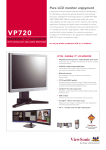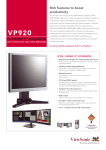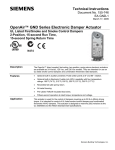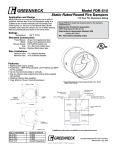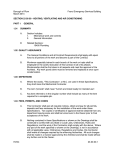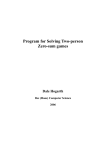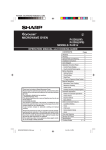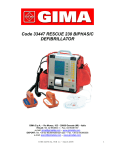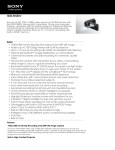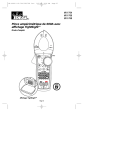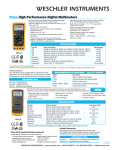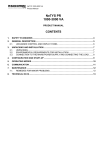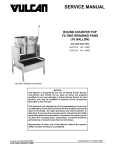Download Siemens 332-2856 AP 331-3 User's Manual
Transcript
Technical Instructions Document No. 155-029P25 AP 331-3 December 3, 2004 POWERS™ Controls No. 6 Pneumatic Damper Actuator 331-2793 Actuator 331-2857 Actuator with Clevis and Pin 331-3012 Extended Shaft and Frame Mounting Description The POWERS Controls No. 6 Pneumatic Damper Actuator is a heavy-duty, rolling diaphragm, spring return actuator designed to drive large dampers, centrifugal refrigeration inlet vanes, and other applications requiring a large, effective diaphragm area and long stroke. Features • All metal body construction • Replaceable ozone-resistant, silicone rubber, rolling diaphragm • Pivot mounting for extended shaft or frame mounting • Positioning relay (optional) • Adjustable forward travel stops (optional) • Three spring ranges for sequencing with other control devices Product Numbers Application See Table 1. The No. 6 Pneumatic Damper Actuator controls outdoor, return air, exhaust, face and bypass, and fan discharge dampers. It is recommended for heavy-duty applications using multi-section dampers where either unison or sequence operation is required. Certain actuators in Table 1 are UL Recognized Components for fire/smoke applications under category EMKU2. This category covers pneumatic damper actuators used on fire dampers and leakage rated dampers. Siemens Building Technologies, Inc. Technical Instructions Document No. 155-029P25 December 3, 2004 POWERS™ Controls No. 6 Pneumatic Damper Actuator Table 1. Product Numbers for No. 6 Pneumatic Damper Actuators. Product Numbers Nominal Spring Range Description Mounting Style Actuator, integral pivot 3-8 psi (21-55 kPa) 3-13 psi (21-90 kPa) 8-13 psi (55-90 kPa) 1 Pivot 331-2793 331-2794 331-3060 Actuator, integral pivot and forward travel stops (Figure Pivot 1) — 331-2796 331-2988 331-2858 331-28561 Actuator with clevis for frame mounting (Figure 2) or remote extended shaft mounting (Figure 3) Pivot2 331-2857 Actuator with clevis and positioning relay (Figure 16) Pivot 2 — Actuator, integral pivot with pivot post 3 Actuator, integral pivot with pivot post and positioning relay3 (Figure 16) 1 2 3 Extended Shaft Extended Shaft with Positioning Relay 331-3012 — — 331-3013 — 332-2856 331-30111 332-3011 UL Recognized Components for Fire/Smoke Applications. Also order frame mounting kit accessories. Mounted on plate for extended shaft with clevis and crank for 3/8-inch (10-mm), 7/16-inch (11-mm), or 1/2-inch (13-mm) diameter shaft. Parts for frame mounting (blade drive) included with kit. NOTE: When the actuator is ordered with universal mounting, the mounting plate, pivot post and hardware, clevis, damper crank, rocker arm, and all screws/nuts are included. Order other frame mounting accessories as required, if not supplied by damper manufacturer. Specifications Effective diaphragm area Stroke Housing Stem Diaphragm Spring Bearing Maximum air pressure Nominal spring ranges Ambient temperature range Operation Air connection Type of mounting Thrust and torque rating Dimensions Shipping Weight Agency Approvals Page 2 17.9 inches2 (115 cm2) 4 inch (102 mm) Aluminum Type 416 stainless steel Ozone-resistant silicone rubber Steel Bronze oilite 30 psig (210 kPa) 3 to 8 psi (21 to 55 kPa) 3 to 13 psi (21 to 90 kPa) 8 to 13 psi (55 to 90 kPa) -20°F to 200°F (-29°C to 93°C) 1/8-inch NPT Pivot, universal (extended shaft or frame mount) See Table 2 See Figure 13 through Figure 16 9 lb (4.08 kg) Complies with UL555 and UL555S Siemens Building Technologies, Inc. POWERS™ Controls No. 6 Pneumatic Damper Actuator Accessories Service Kits Technical Instructions Document No. 155-029P25 December 3, 2004 Damper shaft extension kits: 1/2-inch (13-mm) diameter, 2-1/4 inch (57-mm) rod (See TB-128 POWERS™ Controls Damper Shaft Extension Technical Bulletin 155-205P25) 1/2-inch (13-mm) diameter, 9-inch (229-mm) long hollow rod 1/2-inch (13-mm) diameter, 9-inch (229-mm) long rod 1–inch (25–mm) diameter 11-5/8 inch (295-mm) long (Ruskin) Damper shaft extension kit adapter - 3/8 inch (10 mm) diameter (for use with Damper Shaft Extension Kit 333-042) Actuator shaft extensions: 10-1/8 inch (257-mm) long Adapter kit for 1/2-inch NPT pipe Cranks - damper shaft: 3/8-inch (10-mm) - 1/2-inch (13-mm) diameter, Selectable radius 5/8-inch (16-mm) diameter 3/4-inch (19-mm) diameter 1-inch (25-mm) diameter Cast iron crank with set screws Linkage kit, 4-inch (102-mm) link and crank Universal mounting plate 3/4-inch shaft 1-inch shaft (use with 333-194) Flange bearing (1/2 inch, 13 mm) (for 331-623 Universal Mounting Plate) Right angle mounting plate Remote mounting kit (extended shaft), Figure 3 Positioning relay Positioning relay mounting kit Frame mounting kits One-section damper (Figure 5) Two-section damper (Figure 6) * Order frame mounting kits and damper blade clip kit from Arrow United Industries. Frame mounting lug Mounting lug screws (three required for frame mounting lug) Offset Mounting Bracket (Figure 14) Travel Stop Kit (for model 3 and 4 actuators only) Damper Blade Rocker Arm Screws (two) Nuts (two) Silicone diaphragms (package of five) Siemens Building Technologies, Inc. 331-631 333-184 333-042 333–194 331-632 331-434A 333-030 331-941 333-182 333-183 333-181 333-078 331-958 331-623 331-623A 331-862 333-208 331-618 147-2000 147-276 751* 752* 331-569 034-123K 333-176 333-197 333-034 030 510J 041-230J 333-572 Page 3 Technical Instructions Document No. 155-029P25 December 3, 2004 Actuator Sizing POWERS™ Controls No. 6 Pneumatic Damper Actuator The quantity of actuators required depends on several torque factors. To determine the quantity of actuators required for the installation: 1. Obtain damper torque ratings (ft-lb/ft2) from the damper manufacturer. 2. Determine the area of the damper. 3. Calculate the total torque required to move the damper: Total Torque = Torque Rating x Damper Area 4. Calculate the total quantity of actuators required: Number of = Actuators 1 Total Damper Torque Required SF1 × Actuator Torque (see Table 2) Safety Factor: When calculating the number of actuators required, a safety factor should be included for unaccountable variables such as slight misalignments, aging of the damper, etc. A suggested safety factor is 0.80 (or 80% of the rated torque). See AB-300 Damper Actuator Sizing and Selection Application Bulletin in the HVAC Systems/Controls Reference Data (125-1853) for additional sizing information. See TB-181 Powers™ Controls Maximum Thrust Ratings of Pneumatic Damper Actuators Technical Bulletin (155-219P25) for additional torque requirements. Table 2. Thrust and Torque Rating. Nominal Spring Range Maximum Thrust lb. (N) Full Stroke Forward Spring Return (No Stroke) 15psi 18 psi 25 psi (103 kPa) (124 kPa) (172 kPa) 0 psi (0 kPa) Torque Rating* lb-in (Nm) 2-Position Operation Gradual or Positioner Operation 15 psi 18 psi 25 psi (103 kPa) (124 kPa) (172 kPa) 50 (5.6) 75 (8.5) 75 (8.5) 75 (8.5) 3-8 psi (21-55 kPa) 125 (556) 179 (796) 304 (1352) 54 (240) 3-13 psi (21-90 kPa) 36 (160) 89 (396) 214 (952) 54 (240) 50 (5.6) 8-13 psi 36 (160) 89 (396) 214 (952) 144 (640) (55-90 kPa) * With maximum hysteresis of 2.5 psi (17.2 kPa) @ 90° rotation. 50 (5.6) Page 4 75 (8.5) 75 (8.5) 75 (8.5) 202 (22.8) 202 (22.8) 202 (22.8) Siemens Building Technologies, Inc. POWERS™ Controls No. 6 Pneumatic Damper Actuator Operation Standard Actuator (Figure 1) Technical Instructions Document No. 155-029P25 December 3, 2004 The air tubing from a controlling instrument is connected to the actuator’s upper housing. With no control pressure to the actuator, the compression spring forces the spring seat and actuator shaft toward the upper housing, but is limited by the E-ring. As the control pressure increases, the spring compression is overcome and the actuator shaft gradually moves outward. Conversely, as control pressure decreases, the spring returns the shaft to the position at which the air pressure on the diaphragm balances the spring tension. For each value of control pressure there is a corresponding position of the shaft. Table 3. Standard Actuator Components. Figure 1. Standard Actuator. Extended Shaft Mounting—Pivot Actuator Item Part No. Description Qty. Material 1 047-061J Retaining E-ring 1 Steel 2 333-217 1 × 1-1/4 in. Hex Nut 1 Brass 3 — Spring Retainer 1 — 4 — Stem Guide Assembly 1 — 5 — Lower Housing 1 Aluminum 6 333-572 (pkg. of 5) Diaphragm 1 Silicone rubber 7 599-00413 5/16 in.-18 × 1 Large Hex Cap Screw 6 Steel 8 — Upper Housing 1 Aluminum — Helical Compression Spring 1 9 331-091 3 to 13 psi (21 to 90 kPa) — 331-208 3 to 8 psi (21 to 55 kPa) — 331-094 8 to 13 psi (55 to 90 kPa) — 10 — Piston Plate and Stem Assembly 1 Aluminum/ SS 11 — Retaining C-ring 1 Steel 12 333-197 Stop Kit (Optional) — Steel 1. Order one of the following and see Table 4 for parts lists: Actuator: 331-3011, 331,-3012, 331-3013, or 332-3011 2. Slip the 3/4-inch (19-mm) diameter hole in the mounting plate over the damper shaft. 3. Slip the crank over the damper shaft. With the actuator assembly to the left of the damper shaft, an increase in actuator pressure rotates the damper blade CW when the crank is above the damper shaft, or CCW when the crank is below the damper shaft. See Figure 2. With the actuator assembly to the right of the damper shaft, an increase in actuator pressure rotates the damper blade CCW when the crank is above the damper shaft or CW when the crank is below the damper shaft. 4. Position the mounting plate and attach it to the duct with four screws. 5. When the actuator cannot be directly mounted, drive the extended damper shaft using the Remote Mounting Kit 331-618 and Actuator 331-2856. See Figure 3. Siemens Building Technologies, Inc. Page 5 Technical Instructions Document No. 155-029P25 December 3, 2004 POWERS™ Controls No. 6 Pneumatic Damper Actuator Table 4. Extended Shaft/Frame Mounting Assemblies Components. Item Part No. Description Qty. Material 1 041-162J Nut 1 Steel 2 046-020K Lockwasher 1 Steel 3 047-061K Retaining E-ring 2 Steel 4 331-565 Pivot Post 1 Steel 5 041-142 Nut 1 Steel 6 333-207 Clevis 1 Zinc Plated Steel 7 331-293 Clevis Pin 1 Zinc Plated Steel 8 331-807 Hitch Pin 1 Zinc Plated Steel 9 331-941 Crank Assembly 1 — 10 331-623 Actuator Mounting Plate 1 Steel — 034-283 Mounting Screws 4 Steel Figure 2. Extended Shaft/Frame Mounting Actuator Assembly. Figure 3. Remote Mounting Kit 331-618 with 331-2856 Actuator Mounted. Frame Mounting Type A Page 6 Order one each of the following. See Table 4 for parts lists: Actuator and Clevis: 331-2856, 331-2857, or 331-2858 Frame Mounting Kit: 751 for one-section damper, or 752 for two-section damper All frame mounting kits must be ordered from Arrow United Industries. Siemens Building Technologies, Inc. POWERS™ Controls No. 6 Pneumatic Damper Actuator One-Section Damper Kit 751 See Figure 4 and Figure 5 Technical Instructions Document No. 155-029P25 December 3, 2004 1. Attach the damper mounting bracket to the lower right-hand corner (or upper left-hand corner if necessary) of the damper section with the six screws provided. For Arrow United Industries 1770 dampers, add the shim provided between the bracket and bottom of the frame. Have the damper manufacturer drill the holes in the damper frame (Figure 5). 2. Have the damper manufacturer drill the holes in the damper blade for the blade clips (Figure 4). Use the same clip location for both normally open and normally closed dampers. Attach the damper blade clip to the damper blade (Figure 4). Put the damper in its normal position, open or closed. Connect the push rod to the trunnion in the blade clip and tighten the setscrew. Connect the other end of the push rod to the crank on the drive shaft and tighten the trunnion setscrew on the push rod. Position the crank so the push rod is parallel to the bracket, then tighten the crank setscrews. 3. lnstall the actuator in the actuator support bracket using the pivot shaft and hitch pins. The pivot shaft should be in the holes about 17-1/2 inch (445 mm) from the drive shaft. The actuator support bracket can also mount in the vertical position for installations where space is limited. Figure 4. Damper Blade Clip. 4. Position the crank driven by the actuator as follows: a. Normally open damper: the crank is above the drive shaft. b. Normally closed damper: the crank is below the drive shaft. 5. Connect the actuator clevis to the crank. Put the damper in its normal position, open or closed. Stroke the actuator 1/4-inch (6 mm) with a hand pump, then tighten the crank setscrews. This will ensure tight damper closure. Figure 5. One-section Damper. Siemens Building Technologies, Inc. Page 7 Technical Instructions Document No. 155-029P25 December 3, 2004 Frame Mounting Type A, Continued Two-Section Damper Kit 752 POWERS™ Controls No. 6 Pneumatic Damper Actuator 1. Follow the steps in One-Section Damper. 2. Attach the Damper Blade Clip to the damper blade in the second damper section. Repeat Step 2 in One-Section Damper. The push rod will connect to the extra crank on the drive shaft. See Figure 6 and Figure 7 Figure 6. Two-section Damper. Figure 7. Actuator and Clevis Assembly 331-2857 (Typical) Attached to Frame Mounting Kit 752. Dimensions in Inches (Millimeters). Page 8 Siemens Building Technologies, Inc. POWERS™ Controls No. 6 Pneumatic Damper Actuator Technical Instructions Document No. 155-029P25 December 3, 2004 Frame Mounting Type B 1. Order one each of the following: Actuator assembly: 331-3011, 331-3012, 331-3013, or 332-3011 Mounting Lug: 331-569 See Figure 8 through Figure 10 2. Weld the mounting lug parallel and 5/16-inch (8 mm) from the inside edge of the damper frame and perpendicular to it. See Figure 8. Weld the lug along both sides. The lug should be as close as possible to the corner of the damper frame to minimize deflection. The damper manufacturer should weld the lug. Figure 8. Frame Mounting—Type B. Dimensions in Inches (Millimeters). 3. If the damper frame is aluminum, light gauge sheet metal, or an unusual shape, bolt a 3/16-inch (5-mm) thick, flat piece of steel to the frame. Then weld the mounting lug to it. 4. Attach Rocker 333-034 to blade in proper position for normally open or normally closed damper using 2 nuts, 041-230K, and 2 screws, 030-510J. See Figure 9 and Figure 10. 5. Attach the mounting plate to the mounting lug as follows: a. Normally Open damper: attach the plate to the lug. Place the pivot post in Hole 4. See Figure 9. b. Normally Closed damper: attach the plate to the lug. Place the pivot post in Hole 3. See Figure 10. 6. Fasten the clevis to the rocker. Discard the crank and other parts not used. 7. The actuator mounting plate has a tendency to pivot at the point where the lug is welded to the damper frame when the actuator strokes. It is recommended that some means be devised in the field to prevent this from happening. A threaded rod attached to the mounting plate and duct wall will normally work. Siemens Building Technologies, Inc. Page 9 Technical Instructions Document No. 155-029P25 December 3, 2004 POWERS™ Controls No. 6 Pneumatic Damper Actuator Frame Mounting - Type B, Continued Figure 9. Frame Mounting, Normally Open Damper. Figure 10. Frame Mounting, Normally Closed Damper. Actuator Mounting Table 5. Mounting Plate Hole Identification. Hole 1 Used For No. 6 Actuator extended shaft mounting. 2 Not used. 3 No. 4 Actuator extended shaft. No. 6 Actuator frame mounting NC 4 No. 6 Actuator frame mounting NO 5 No. 4 Actuator frame mounting NC 6 No. 4 Actuator frame mounting NO Figure 11. Actuator Mounting Plate 331-623 Pivot Shaft Locations. Dimensions in Inches (Millimeters). Table 6. Pivot Post Hole Identification. Figure 12. Actuator Mounting Plate 331-623A Pivot Shaft Locations. Page 10 Hole Used For 1 2 3 No. 6 Actuator extended shaft mounting Not used No. 4 Actuator extended shaft 4 5 No. 6 Actuator frame mounting NC No. 6 Actuator frame mounting NO No. 4 Actuator frame mounting NC 6 No. 4 Actuator frame mounting NO Siemens Building Technologies, Inc. POWERS™ Controls No. 6 Pneumatic Damper Actuator Technical Instructions Document No. 155-029P25 December 3, 2004 Dimensions Figure 13. Extended Shaft Remote Mounting with Travel Stops. Dimensions in Inches (Millimeters). Offset Mounting Bracket This bracket is designed to offset Universal Mounting Plate 331-623 or 331-623A from the ductwork. NOTE: Depending on the application, two brackets may be required to support the actuator and universal mounting plate. Siemens Building Technologies, Inc. Figure 14. Offset Mounting Bracket 333-176. Dimensions in Inches (Millimeters). Page 11 Technical Instructions Document No. 155-029P25 December 3, 2004 POWERS™ Controls No. 6 Pneumatic Damper Actuator Dimensions, Continued Figure 15. Actuator Mounting Plate 331-623. Dimensions in Inches (Millimeters). Figure 16. No. 6 Actuator with the RL 147 Positioning Relay Mounting. Dimensions in Inches (Millimeters). Information in this publication is based on current specifications. The company reserves the right to make changes in specifications and models as design improvements are introduced. POWERS is a trademark of Siemens Building Technologies, Inc. Other product or company names mentioned herein may be the trademarks of their respective owners. © 2004 Siemens Building Technologies, Inc. Siemens Building Technologies, Inc. 1000 Deerfield Parkway Buffalo Grove, IL 60089-4513 U.S.A. Your feedback is important to us. If you have comments about this document, please send them to [email protected] Document No. 155-029P25 Country or Origin: US Page 12












